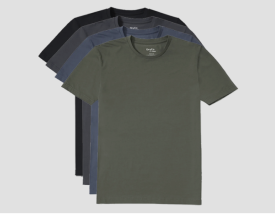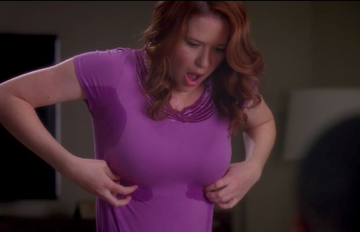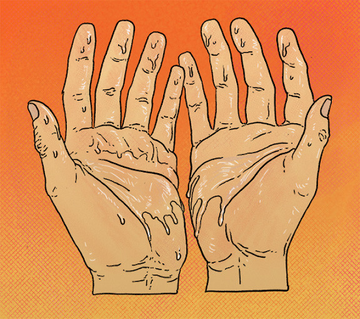Hyperhidrosis terminology may seem confusing since there are different labels for the condition. Experts and sufferers alike may use some terms interchangeably or inaccurately. Some terms are completely misunderstood or mysterious. Here’s a quick breakdown of these terms to clarify their meanings.
Anhidrosis
The opposite of hyperhidrosis, anhidrosis is the inability to sweat normally or sweat at all. Although this may provoke the envy of some hyperhidrosis sufferers, anhidrosis is a dangerous condition because it prevents the body from cooling down. This leads to overheating or heat strokes, the latter of which can be fatal.
Axillary Hyperhidrosis
This term refers to excessive sweating from the armpits. Axillary hyperhidrosis often begins in late adolescence although it can start earlier in some people. Doctors usually recommend aluminum-based antiperspirants to reduce axillary hyperhidrosis. They may also suggest botox injections and anticholinergic drugs or wipes in other cases. Sweatproof shirts that contain moisture-wicking fabrics can provide relief and comfort for individuals with axillary hyperhidrosis.
Bromhidrosis
Also known as osmidrosis, bromhidrosis is the scientific term for malodorous (foul-smelling) human perspiration, what we refer to as B.O. It’s usually localized and worse in regions such as the armpit or the groin, regions that are heavily populated with apocrine glands (responsible for body odour). Bromhidrosis can affect anyone (although men tend to have it worse) yet it doesn’t often occur in people who have hyperhidrosis.
Craniofacial Hyperhidrosis
This form of hyperhidrosis refers to excessive sweating of the face, head and scalp. It may or may not occur with sweating in other regions. Craniofacial hyperhidrosis is one of the most challenging forms of the condition to deal with, because patients can’t easily hide it and may rely on exhausting methods to do so (ie. wearing hats, constantly wiping sweat with a cloth). Treatments for craniofacial hyperhidrosis may include botox injections, anticholinergics (drugs or wipes) and/or antiperspirants.
Focal Hyperhidrosis
Also known as primary hyperhidrosis, focal hyperhidrosis refers to excessive sweating that occurs by itself, without any other known cause. It affects somewhere between 1% and 3% of the general population and often affects one or more bodily regions (ie. palms, armpits, feet). Researchers believe that the cause of focal hyperhidrosis is genetic and have found strong evidence that the neurotransmitter, acetylcholine, plays a role in its occurrence as well.
Palmar hyperhidrosis
This term refers to the unpredictable and excessive sweating of the hands. Individuals with palmar hyperhidrosis may find that their hands sweat even when they are cool, at rest or free of stress and anxiety. It is one of the most common forms of hyperhidrosis. Sufferers often treat this form with anticholinergics (drugs or wipes), antiperspirants, botox injections or iontophoresis.
Plantar Hyperhidrosis
Plantar hyperhidrosis refers to excessive sweating on the soles of the feet. This form of hyperhidrosis can present itself with unique complications in the form of bacterial/fungal infections and friction blisters due to the sensitivity of skin on the foot. Depending on the individual, plantar hyperhidrosis may also be accompanied by an odour.
Palmoplantar Hyperhidrosis
In palmoplantar hyperhidrosis, a sufferer exhibits excessive sweating in both their hands and feet. This form of hyperhidrosis tends to start in one’s pre-teen and early teen years. Treating this form of hyperhidrosis often requires a combination of treatments including anticholinergic drugs, sweat resistant apparel (ie. sweat resistant socks, gloves) and more aggressive treatments such as iontophoresis machines or botox.
Secondary Hyperhidrosis
The opposite of primary (focal) hyperhidrosis, secondary hyperhidrosis refers to a case of excessive sweating that occurs as a symptom of an underlying condition. For example, diseases such as hyperthyroidism, diabetes, and Parkinson’s Disease can lead to excessive sweating. Treating the underlying disorder can reduce or eliminate excessive sweating altogether. In some cases, excessive sweating can occur as a side effect of taking prescription or recreational drugs. Adjusting doses, switching medications or quitting recreational drugs can also relieve excessive sweating.
Defining Hyperhidrosis
Hyperhidrosis is a condition that affects people in varying degrees. Not only does that mean differences in severity, but also, differences in presentation (location and combination). This is why there are so multiple terms and classifications for the condition. Knowing the differences between these terms is a form of empowerment and knowledge that can help sufferers come to terms with the condition.
Want to learn more about hyperhidrosis and ways to manage it? Check out our Neat Freaks blog for helpful tips and insights to control excessive sweating.








